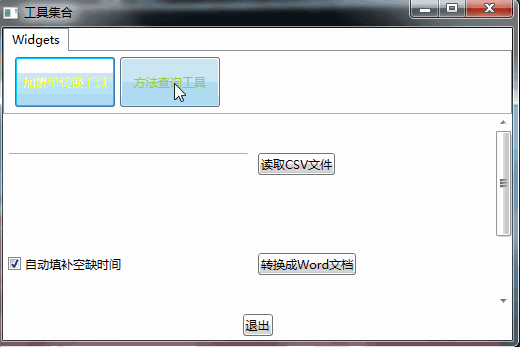这两天看到同事的一个小工具,用的是模块式开发,也就是俗称的插件开发,用的是反射+接口的方式实现的。感觉挺好的,也就学习了一下,写个小Demo,在此记录下。
一、写接口类
接口类是所有模块的基础,因为让主程序去寻找模块,就是通过反射来找到继承此接口的相关项目,也就是后期包含继承此接口类的DLL文件。
此接口类包含以下几个属性
工具的名称(必需)、是否要弹出、前景色、背景色、工具启动方法(必需)
public interface IToolsInterface { /// <summary> /// 获取工具名称 /// </summary> string ToolName { get; } /// <summary> /// 是否弹出 /// </summary> bool IsPopUp { get; } /// <summary> /// 前景色 /// </summary> Brush ForgroundBrush { get; } /// <summary> /// 背景色 /// </summary> Brush BackgroundBrush { get; } /// <summary> /// 工具启动方法 /// </summary> /// <returns></returns> FrameworkElement RunToolApplication(); }
二、写主窗体
所谓的主窗体,也就是各个模块的承载器而已,因为各个模块都是UserControl,需要窗体来承载。
需要的方法大概有两个,寻找目录的层级、创建相应的模块。
1、寻找目录层级
因为模块最终要生成到一个位置,然后让主程序去搜索,所以,需要一个搜索方法,去寻找
/// <summary> /// 查找指定目录下的所有末级子目录 /// </summary> /// <param name="dir">要查找的目录</param> /// <param name="dirList">查找结果列表</param> /// <param name="system">是否包含系统目录</param> /// <param name="hidden">是否包含隐藏目录</param> public static void GetEndDirectories(DirectoryInfo dir,List<DirectoryInfo> dirList,bool system=false,bool hidden=false) { try { //返回当前目录的子目录集合 DirectoryInfo[] dirSub = dir.GetDirectories(); if(dirSub.Length==0) { //如果没有子目录了则添加进列表 dirList.Add(dir); return; } foreach (DirectoryInfo subItem in dirSub) { //跳过系统目录 if (!system && (subItem.Attributes & FileAttributes.System)==FileAttributes.System) { continue; } //跳过隐藏目录 if (!hidden && (subItem.Attributes & FileAttributes.Hidden)==FileAttributes.Hidden) { continue; } //递归 GetEndDirectories(subItem, dirList); } } catch (Exception ex) { MessageBox.Show("获取目录层级失败。" + ex.Message); } }
2、创建相应模块
当存在一个DLL时,就生成一个模块,两个DLL时就要有两个模块,以此类推……
/// <summary> /// 创建功能按钮 /// </summary> /// <param name="toolsInterface"></param> /// <returns></returns> private UIElement CreateFunction(IToolsInterface toolsInterface) { Button btn = new Button(); btn.Click += Btn_Click; btn.Content = toolsInterface.ToolName; btn.Width = 100; btn.Height = 50; btn.Margin = new Thickness(5, 0, 0, 0); btn.Background = toolsInterface.BackgroundBrush; btn.Foreground = toolsInterface.ForgroundBrush; btn.Tag = toolsInterface; return btn; } private void Btn_Click(object sender, RoutedEventArgs e) { Button btn = sender as Button; if(btn!=null) { IToolsInterface toolsInterface = btn.Tag as IToolsInterface; if(toolsInterface !=null) { FrameworkElement control = toolsInterface.RunToolApplication(); gUc.Children.Clear(); gUc.Children.Add(control); } else { MessageBox.Show("实例化接口失败"); } } else { MessageBox.Show("实例化按钮失败"); } }
3、加载模块
private void LoadWidgets() { string applicationPath = AppDomain.CurrentDomain.SetupInformation.ApplicationBase; string dirPath = applicationPath + "Widgets/"; if(!Directory.Exists(dirPath)) { MessageBox.Show("未找到相关的Widgets文件夹信息,请确认相关的文件夹是否存在。"); return; } DirectoryInfo dir = new DirectoryInfo(dirPath); List<DirectoryInfo> lastDirNameList = new List<DirectoryInfo>(); Tools.FileToolsHelper.GetEndDirectories(dir, lastDirNameList); foreach (DirectoryInfo item in lastDirNameList) { WrapPanel wrapPanel = null; TabItem tabItem = Tools.UCToolsHelper.CreateTabByDirName(item.Name,tcToolkClass); wrapPanel = Tools.UCToolsHelper.CreateWrapPanel(tabItem); string[] dllFilesPath = Directory.GetFiles(item.FullName, "*.dll"); foreach (string dllPath in dllFilesPath) { Assembly assembly = Assembly.LoadFile(dllPath); Type[] types = assembly.GetExportedTypes(); foreach (Type type in types) { if(typeof(IToolsInterface).IsAssignableFrom(type)&&!type.IsAbstract) { IToolsInterface toolInterface = Activator.CreateInstance(type) as IToolsInterface; if (toolInterface !=null) { wrapPanel.Children.Add(CreateFunction(toolInterface)); } } } } } }
三、写相应的模块部分
最近也没写什么小东西,就把原来做的两个Winform东西,直接搬过来,弄成了WPF的,把窗体改成了UserControl,额外加了一个类,用来实现第一部分提到的接口。
其中一个小工具在这:http://www.cnblogs.com/ZXdeveloper/p/5682230.html
基本东西不动,只是加了一个FunctionHelper用来实现接口,此处需要注意,一定是Public,否则查询不到
public class FunctionHelper : IToolsInterface { public Brush BackgroundBrush { get { return new SolidColorBrush(Colors.LightBlue); } } public Brush ForgroundBrush { get { return new SolidColorBrush(Colors.YellowGreen); } } public bool IsPopUp { get { return false; } } public string ToolName { get { return "方法查询工具"; } } public FrameworkElement RunToolApplication() { return new SearchUC(); } }
四、看一下效果图

大概也就这么一个流程,不是很难,方便了后期的开发。
DEMO还有很多不完善的地方,我会慢慢弄,后期会不断的完善